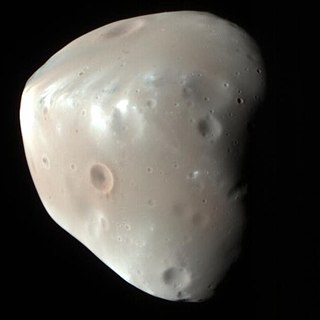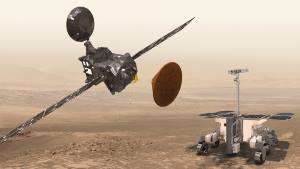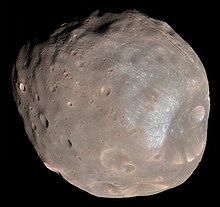
Phobos is the innermost and larger of the two natural satellites of Mars, the other being Deimos. The two moons were discovered in 1877 by American astronomer Asaph Hall. It is named after Phobos, the Greek god of fear and panic, who is the son of Ares (Mars) and twin brother of Deimos.

Deimos is the smaller and outer of the two natural satellites of Mars, the other being Phobos. Deimos has a mean radius of 6.2 km (3.9 mi) and takes 30.3 hours to orbit Mars. Deimos is 23,460 km (14,580 mi) from Mars, much farther than Mars's other moon, Phobos. It is named after Deimos, the Ancient Greek god and personification of dread and terror.

A lander is a spacecraft that descends towards, then comes to rest on the surface of an astronomical body other than Earth. In contrast to an impact probe, which makes a hard landing that damages or destroys the probe upon reaching the surface, a lander makes a soft landing after which the probe remains functional.

The planet Mars has been explored remotely by spacecraft. Probes sent from Earth, beginning in the late 20th century, have yielded a large increase in knowledge about the Martian system, focused primarily on understanding its geology and habitability potential. Engineering interplanetary journeys is complicated and the exploration of Mars has experienced a high failure rate, especially the early attempts. Roughly sixty percent of all spacecraft destined for Mars failed before completing their missions, with some failing before their observations could even begin. Some missions have been met with unexpected success, such as the twin Mars Exploration Rovers, Spirit and Opportunity, which operated for years beyond their specification.

Mars 96 was a failed Mars mission launched in 1996 to investigate Mars by the Russian Space Forces and not directly related to the Soviet Mars probe program of the same name. After failure of the second fourth-stage burn, the probe assembly re-entered the Earth's atmosphere, breaking up over a 320 km (200 mi) long portion of the Pacific Ocean, Chile, and Bolivia. The Mars 96 spacecraft was based on the Phobos probes launched to Mars in 1988. They were of a new design at the time and both ultimately failed. For the Mars 96 mission the designers believed they had corrected the flaws of the Phobos probes, but the value of their improvements was never demonstrated due to the destruction of the probe during the launch phase.

The Aurora programme was a human spaceflight programme of the European Space Agency (ESA) established in 2001. The objective was to formulate and then to implement a European long-term plan for exploration of the Solar System using robotic spacecraft and human spaceflight to investigate bodies holding promise for traces of life beyond the Earth.

ExoMars is an astrobiology programme of the European Space Agency (ESA) and the Russian space agency (Roscosmos).

Fobos-Grunt or Phobos-Grunt was an attempted Russian sample return mission to Phobos, one of the moons of Mars. Fobos-Grunt also carried the Chinese Mars orbiter Yinghuo-1 and the tiny Living Interplanetary Flight Experiment funded by the Planetary Society.

A Moon landing or lunar landing is the arrival of a spacecraft on the surface of the Moon, including both crewed and robotic missions. The first human-made object to touch the Moon was Luna 2 in 1959.

The two moons of Mars are Phobos and Deimos. They are irregular in shape. Both were discovered by American astronomer Asaph Hall in August 1877 and are named after the Greek mythological twin characters Phobos and Deimos who accompanied their father Ares into battle. Ares, the god of war, was known to the Romans as Mars.

A sample-return mission is a spacecraft mission to collect and return samples from an extraterrestrial location to Earth for analysis. Sample-return missions may bring back merely atoms and molecules or a deposit of complex compounds such as loose material and rocks. These samples may be obtained in a number of ways, such as soil and rock excavation or a collector array used for capturing particles of solar wind or cometary debris. Nonetheless, concerns have been raised that the return of such samples to planet Earth may endanger Earth itself.

A Mars sample-return (MSR) mission is a proposed mission to collect rock and dust samples on Mars and return them to Earth. Such a mission would allow more extensive analysis than that allowed by onboard sensors.

The idea of sending humans to Mars has been the subject of aerospace engineering and scientific studies since the late 1940s as part of the broader exploration of Mars. Long-term proposals have included sending settlers and terraforming the planet. Currently, only robotic landers and rovers have been on Mars. The farthest humans have been beyond Earth is the Moon, under the NASA's Apollo program.
Hayabusa Mk2 was a proposed Japan Aerospace Exploration Agency (JAXA) space mission aimed at visiting a small primitive asteroid and returning a sample to Earth for laboratory analysis. It was intended to be the follow-on mission to JAXA's Hayabusa mission, as well as the Hayabusa2 mission. The latest proposal for Hayabusa Mk2 stated its target to be the dormant comet 4015 Wilson–Harrington, with a launch of the probe in 2018. From 2007 to 2010, it was also considered as a joint JAXA-ESA mission under the name Marco Polo. The in-situ investigation and sample analysis would allow scientists to improve our knowledge of the physical and chemical properties of a small Near-Earth Object (NEO) which is thought to have kept the original composition of the solar nebula in which planet formed. Thus, it would provide some constraints to the models of planet formation and some information on how life may have been brought to Earth. Information on the physical structure will help defining efficient mitigation strategies against a potential threatening object.

Chang'e 5 was the fifth lunar exploration mission in the Chinese Lunar Exploration Program of CNSA, and China's first lunar sample-return mission. Like its predecessors, the spacecraft is named after the Chinese moon goddess, Chang'e. It launched at 20:30 UTC on 23 November 2020, from Wenchang Spacecraft Launch Site on Hainan Island, landed on the Moon on 1 December 2020, collected ~1,731 g (61.1 oz) of lunar samples, and returned to the Earth at 17:59 UTC on 16 December 2020.

The Asteroid Redirect Mission (ARM), also known as the Asteroid Retrieval and Utilization (ARU) mission and the Asteroid Initiative, was a space mission proposed by NASA in 2013; the mission was later cancelled. The Asteroid Retrieval Robotic Mission (ARRM) spacecraft would rendezvous with a large near-Earth asteroid and use robotic arms with anchoring grippers to retrieve a 4-meter boulder from the asteroid.

Phobos And Deimos & Mars Environment (PADME) is a low-cost NASA Mars orbiter mission concept that would address longstanding unknowns about Mars' two moons Phobos and Deimos and their environment.

Martian Moons eXploration (MMX) is a robotic space probe set for launch in 2026 to bring back the first samples from Mars' largest moon Phobos. Developed by the Japan Aerospace Exploration Agency (JAXA) and announced on 9 June 2015, MMX will land and collect samples from Phobos once or twice, along with conducting Deimos flyby observations and monitoring Mars's climate.

The Planetary Exploration of China, also known as Tianwen, is the robotic interplanetary spaceflight program conducted by the China National Space Administration (CNSA). The program aims to explore planets of the Solar System, starting from Mars, and will be expanded to Jupiter and more in the future.





















